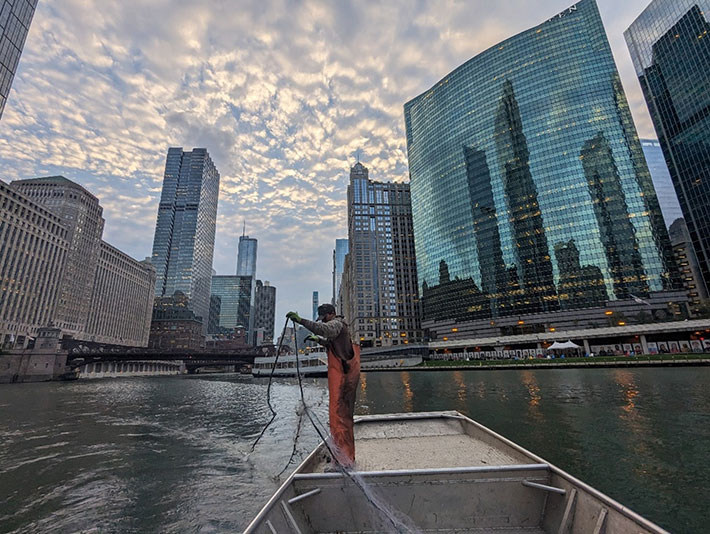No invasive carp found during intensive monitoring in Chicago Area Waterway System
November 29, 2023

An Illinois Department of Natural Resources-contracted fishing crew sets gill nets in the Chicago River to sample for invasive carp.
Photo by Claire Snyder/Illinois Department of Natural Resources.
No bighead, silver, or grass carp were captured or observed in the Chicago Area Waterway System (CAWS) after two weeks of rigorous sampling were conducted in October 2023 during the annual Fall Seasonal Intensive Monitoring event. Seasonal Intensive Monitoring sampling is conducted in the CAWS twice a year in the spring and fall and is an intensive interagency effort designed to detect live bighead or silver carp.
The CAWS connects the Mississippi River watershed to the Great Lakes watershed and represents a possible vulnerable pathway for invasive carp to reach Lake Michigan. The current invasive carp invasion front is approximately 47 miles from Lake Michigan and is heavily monitored, with harvest efforts designed to remove carp and reduce the risk of upstream movement. Furthermore, the Electric Dispersal Barrier System is active in Romeoville, 37 miles from Lake Michigan, and represents an additional line of defense against upstream carp movement. Though invasive carp remain well downstream of Lake Michigan, sampling efforts in the CAWS still a play a critical role in assessing any population changes and providing a first response capability in the event of any invasive carp detections.
Each spring and fall, partner agencies under the leadership of the Illinois Department of Natural Resources meticulously sample hundreds of sites in the CAWS in their efforts to detect invasive carp. This fall, sampling was conducted from October 2 to October 13. Crews from Illinois Department of Natural Resources, Illinois Natural History Survey, U.S. Fish and Wildlife Service, U.S. Army Corps of Engineers, and Illinois Department of Natural Resources-contracted commercial fishers scoured the CAWS using boat electrofishing and gill nets. In total, crews conducted 72.5 hours of electrofishing across 312 different locations and set 50.5 miles of gill net at 444 different locations. The densest sampling was conducted in the Calumet River and Lake Calumet, where a live silver carp was captured on August 4, 2022. However, thorough sampling was also conducted through the entirety of the CAWS. Further intensive sampling efforts will be conducted in the CAWS in spring and fall of 2024.
View the 2023 Invasive Carp Action Plan for more information on the Invasive Carp Regional Coordinating Committee’s comprehensive invasive carp management strategy for protecting the Great Lakes from invasive carp.
View the 2023 Invasive Carp Monitoring and Response Plan for more information on a host of projects dedicated to preventing invasive carp from establishing populations in the Chicago Area Waterway System and Lake Michigan.
